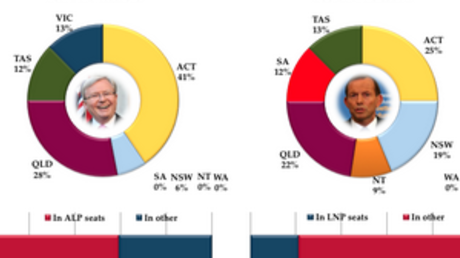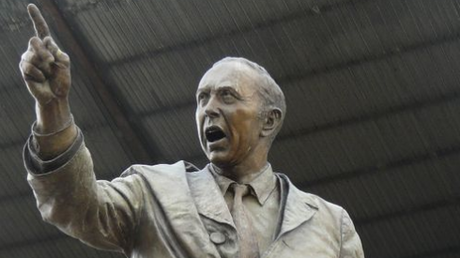The barrage of negative ads has begun.
Australia has a long history of negative political advertising. What we have seen already in this year's campaign, and will keep seeing until polling day, are ads which repeat key themes and metaphors from previous campaigns. This is pretty typical. There is rarely anything new in political advertising. Instead, there is a lot of repetition, borrowing and adaptation - including from overseas, from state campaigns and from what has been judged to have ‘worked’ in past federal elections.
The key themes of Australian political ads are remarkably consistent through time – the centrality of the family, the notion of the election as a choice where voters have to choose the right ‘path’, and the metaphor of movement to symbolise progress, to name just a few. These can be seen in early pamphlets, posters and newspaper ads as well as in later radio, television and now internet political advertising.
Negative ads tend to have their own particular themes.
A particularly Australian classic is the mother in the kitchen talking about how her family will be worse off if an opponent wins the election. Most negative ads use a surrogate to mount the attack (rather than having the leader do it) so it doesn’t rebound on the sponsor of the ad. Labor’s current 'Hiding Susannah' ad is a classic in that genre.
It is strikingly similar to Labor’s famous 1987 TV ads (devised by John Singleton) that featured Wendy Woods standing at her kitchen bench asking John Howard to reveal where the money for his election promises was coming from.
Dubbed ‘Whinging Wendy’, the ads used a woman to attack an opponent to make the attack more palatable and to resonate because she symbolised family values, suburbia and her status as an ordinary, concerned mother. Twenty-six years later, Susannah is standing in her kitchen representing the same things and asking the same question to a different opponent - to Tony Abbott.
Aside from themes, the techniques used in negative ads are also amazingly consistent over time. The golden rules of negative political advertising include:
1. Use the most sinister looking photo of your opponent you can find
(Labor’s ‘If Tony Abbott wins, you lose’ ad, has a particularly sinister photo of Abbott). This type of image is usually in black and white to make him/her look even more sinister. Faces are very important in political ads. They are often zoomed in on, shown in unflattering poses – smirking, frowning, snarling – or shown as a mask.
2. Draw on the metaphor of families and ordinary people being ‘struck down’ by the opponent’s policies.
Looking again at Labor’s ‘If Tony Abbott wins, you lose’, it shows concerned-looking ordinary people standing in spotlights being relegated to the dark as the lights are turned out on them when the serious-sounding voiceover makes claims about how Abbott’s plans will affect people.
Light is a classic political metaphor. Not for nothing was the Liberal’s 1975 slogan ‘Turn on the lights’ after what they characterised as ‘The three dark years’ of Labor’s Whitlam government. But the notion of families being struck down is also common. In 1993, the Liberal Party made a very memorable and controversial ad that showed ordinary people as targets, being viewed through a gunsight and struck down by Labor’s ‘mismanagement’ and failure to stop high unemployment rates.
Labor had a series of ads in 1998 showing family photos with the faces crossed out by a black texta as the voiceover explained how the Howard government had adversely affected them.
3. Draw attention to any internal divisions in your opponent’s party.
The Coalition has been handed a political advertising gift by Labor in this regard and we can expect to see more on that theme. We can also expect, as a challenger, that the Coalition will emphasise Labor’s record in office which is, after all, what challengers are supposed to do. If they want to combine the leadership problems of the ALP with policy and administration problems, maybe they will try a ‘Memories’ style ad.
In 1977, the Liberal Party ran what was considered to be a very effective ad showing a photograph album that was being flicked through as the melancholy song ‘Memories’ played in the background. The album was full of clippings of negative newspaper headlines about the Whitlam government (‘ASIO raid’, ‘Hospital fees up’, ‘Inflation 5%’). Along with ‘It’s Time’, ‘Memories’ is probably one of the best-known Australian political ads for anyone old enough to recall it. It must surely be tempting for the Liberals to run a similar ad showing all of the chaos, disunity, leadership challenges and negative headlines attached to the Rudd and Gillard governments (and News Limited newspapers will have provided plenty of examples for them to choose from).
4. Humour, sarcasm and ridicule can all be powerful weapons.
These tools can be especially effective online where ads are aimed at different audiences and require a different delivery method (passing on the ad or choosing to open it rather than on TV where it comes on during an ad break). Television ads in Australia in recent elections have tended to be more earnest and sombre, but we have seen the occasional attempt at humour including a few efforts in the late 1980s and early 1990s that fell flat. Given the trend towards using humour in the US, maybe the parties here will try to experiment, but it’s probably more likely that they will confine the humour to online and leave it to others while they stick to what they know – aggressive, alarmist, negative advertising.
5. Unpopular leaders are a major target of negative ads.
Labor is already focusing on Abbott and will likely continue to do so. They focused on Peter Costello in earlier years just as the Coalition focussed on Mark Latham. Any doubts about character will be magnified and exaggerated – on both sides.
6. In Australian ads, we see a lot of use of ‘official’ and ‘authoritative’ sources to back up negative claims.
Using newspaper headlines is one example of this, but so too is the use of statistics, quotes and figures with a ‘source’ cited at the bottom to make the claims look credible and trustworthy.
7. Children are a powerful symbol of the future and of innocence that are often used in negative and positive ads alike.
Whatever the election outcome, negative ads – like birth, death and taxes – are a certainty of the election campaign.




